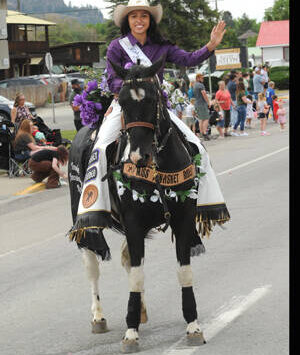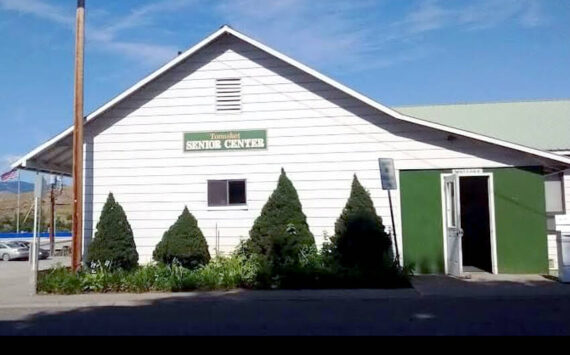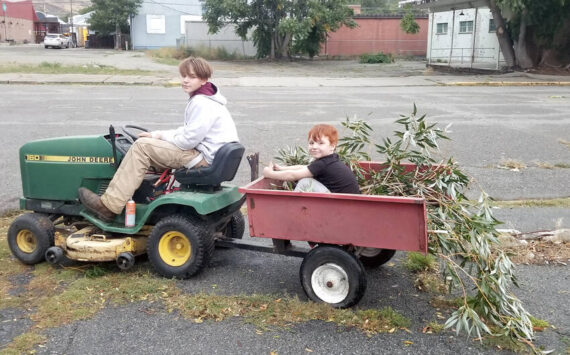Laundry list of concerns discussed
TONASKET – Three representatives of the Washington Department of Transportation engaged in a lengthy discussion with the Tonasket City Council at their Tuesday, Aug. 28, meeting regarding a laundry list of traffic concerns that Mayor Patrick Plumb communicated to the DOT over the summer.
North Central Region Administrator Dan Sarles, along with Local Program director Paul Mahre (a frequent visitor) and one other discussed issues with this summer’s chip seal project on Whitcomb Avenue (including the recently removed “extra” crosswalk) and long-term projects that the council hopes can be addressed at some point.
Plumb’s list included:
- pedestrian safety issues on the south end of Tonasket (due to a lack of crossings);
- poor quality of the chip seal project;
- poor communication during the project on timelines and conditions;
- continuing issues with drainage on Whitcomb Avenue during rainstorms;
- changing the speed limits south of the city limits, particularly in areas that could be annexed in the future;
- roadway degradation from off-street access;
- cooperation between state agencies and the city;
- crosswalk issues in the downtown core;
- potentially adding metric conversions to speed limit signs within the city limits to help Canadian tourists;
- find out the best process to register complaints;
- and discuss the best placement for a bus rider shelter or stop.
Most of the discussion centered around the US-97 (Whitcomb) chip seal project and the future possibility of much-needed, more extensive work to be done in the downtown core.
Sarles said the DOT was not blind to Tonasket’s issues, but that a lack of state-level funding has made it impossible to do more.
“We are trying to squeeze everything out of the dollars we have,” Sarles said, presenting data reflecting financial issues.
He said one way the state has changed its determination on where to do more extensive road work has to do with average daily traffic rates. Though US-97 is a main transport corridor/
“We used to chip seal only routes with (Average Daily Traffic) of 5,000 or less,” Mahre said. “Now we’re doing it in 10,000 ADT or less, and the way funding looks it will be 25,000 or less in the near future.”
He said that Tonasket is in the 6-7,000 ADT range.
“I understand that,” Plumb said. “But I wanted to make sure that you (the DOT) was in receipt of my comments because these will continue to be major issues for us.”
Scott Olson also brought up the topic of the missing wheelchair ramp at Third and Whitcomb, near The Kuhler
“We still have no ramp,” Olson said. “It’s hard to see because there are others that have been replaced. I know the reasons why, but it is still very frustrating.”
Only the state has the jurisdictional right to put in such a ramp along US-97.
“We really need it right there but we keep getting them in other places,” Olson said. “Don’t you have a deal, pay for five, set the sixth one free? I suggest you go take a wheelchair and try to get to the Kuhler from here and see how long it takes you to get there.”
Mosquito vote delay
City planner Kurt Danison of Highlands Associates updated the council on the status of the proposed mosquito control district. At one time it was hoped that a vote on whether or not to form the district would be on this November’s ballot, but Danison said a busy summer kept the Okanogan County commissioners from completing the required hearings for that to happen.
“They opened the public hearing on July 22,” Danison said. “(The Carlton Complex fire) was taking a little time from those folks. so that hearing was continued until (Aug. 28).
“That was continued until Sept. 15. That is basically the end of the window to hold their hearing, then they have a 30-60 days to hold the election. They are within the window of having the election, but not the ability to for the county to do what needs to be done to verify the map, identify the boundaries … they really need 90-120 days to do what needs to be done.”
He said it probably won’t be voted on until April at the earliest and possibly not for another year.
“One of the commissioners said that you should go to your 7th and 12th District legislators and get the ability to get a bill on your utility bills so that only people in the cities would be paying for mosquito control,” Danison said. “We tried to point out that the mosquitoes don’t just breed and grow inside the city limits. A lot of the habitat is outside the city. That might be a way to collect some money but the city can’t go outside the city limits and deal with the mosquitoes on private property, while a mosquito district can.
“So it’s an uphill battle to help them understand that, in order to be effective, it can’t just be a city to city deal, it needs to be a larger area. (For example) the entire area along the river from Oroville to Tonasket should be included, because it’s all habitat, and the mosquitoes can go three to four miles.”
Danison said that many of the decisions can’t be made until a district is formed and the trustees that would be appointed (one each from the five participating cities, and from each of the three districts represented by each county commissioner). They are the ones that will make the decisions about what will it actually do, what will the budget be, and how they’re going to get that money.”
Johnson discusses fire mitigation
Responding to previously raised concerns, Fire Chief/City Permit Administrator Christian Johnson said that ensuring residents maintain their yards as a safety precaution against wildfires was a complicated matter.
“We have abandoned properties that are now bank-owned,” Plumb said. “And there are some property owners that haven’t had (yard maintenance) as their highest priority.”
“We have tried to work with several property owners with request for yard maintenance letters,” Johnson said. “And in some cases the police department has actually issued citations. Unfortunately, some of those people have been ‘frequent fliers.’ A citation, they persistently don’t pay them.
“The other part of its (asking them directly), and that often works. And we can issue citations. The other part of it is, if you don’t fix it, we’ll fix it. If we fix it, we make a special assessment on the property. And if they don’t pay the county treasurer that money … the county treasurer will collect that money by selling the property.”
Johnson said that’s a four or five year process.
Plumb said getting letters out to those property owners at this time might be effective due to the attention brought to the issue by this summer’s fires.
“We had a Biblical event,” Johnson said. “Most of the cities weren’t concerned about having to experience what Pateros did. That was very eye-opening. No one expected to see that here.
“It was a perfect storm … but you could not afford to have a fire department to try to stop that at that time. There were good lessons learned. In the city or small town, a wildfire can move through there just as fast, and houses are combustible.”




